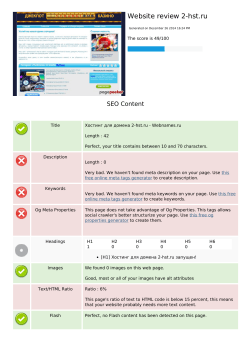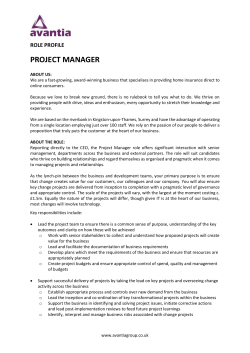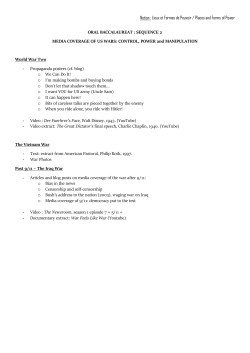
Text Processing with Ruby
Extracted from:
Text Processing with Ruby
Extract Value from the Data That Surrounds You
This PDF file contains pages extracted from Text Processing with Ruby, published
by the Pragmatic Bookshelf. For more information or to purchase a paperback or
PDF copy, please visit http://www.pragprog.com.
Note: This extract contains some colored text (particularly in code listing). This
is available only in online versions of the books. The printed versions are black
and white. Pagination might vary between the online and printed versions; the
content is otherwise identical.
Copyright © 2015 The Pragmatic Programmers, LLC.
All rights reserved.
No part of this publication may be reproduced, stored in a retrieval system, or transmitted,
in any form, or by any means, electronic, mechanical, photocopying, recording, or otherwise,
without the prior consent of the publisher.
The Pragmatic Bookshelf
Dallas, Texas • Raleigh, North Carolina
Text Processing with Ruby
Extract Value from the Data That Surrounds You
Rob Miller
The Pragmatic Bookshelf
Dallas, Texas • Raleigh, North Carolina
Many of the designations used by manufacturers and sellers to distinguish their products
are claimed as trademarks. Where those designations appear in this book, and The Pragmatic
Programmers, LLC was aware of a trademark claim, the designations have been printed in
initial capital letters or in all capitals. The Pragmatic Starter Kit, The Pragmatic Programmer,
Pragmatic Programming, Pragmatic Bookshelf, PragProg and the linking g device are trademarks of The Pragmatic Programmers, LLC.
Every precaution was taken in the preparation of this book. However, the publisher assumes
no responsibility for errors or omissions, or for damages that may result from the use of
information (including program listings) contained herein.
Our Pragmatic courses, workshops, and other products can help you and your team create
better software and have more fun. For more information, as well as the latest Pragmatic
titles, please visit us at https://pragprog.com.
For international rights, please contact rights@pragprog.com.
Copyright © 2015 The Pragmatic Programmers, LLC.
All rights reserved.
No part of this publication may be reproduced, stored in a retrieval system, or
transmitted, in any form, or by any means, electronic, mechanical, photocopying,
recording, or otherwise, without the prior consent of the publisher.
Printed in the United States of America.
ISBN-13: 978-1-68050-070-7
Encoded using the finest acid-free high-entropy binary digits.
Book version: B1.0—April 29, 2015
CHAPTER 11
Natural Language Processing
Natural language processing is an enormously broad subject, but it in essence
covers any task in which we attempt to use a computer to understand human
language. That might mean using a program to extract meaning from text
written by a human—to translate it, to determine its subject, or to parse its
grammar. Or it might mean using a computer to actually write text for humans
to read—think of a computer working as a journalist, writing summaries of
sports games, financial events, and so on.
What is Natural Language Processing?
As a field, natural language processing (or NLP) features many of the hardest
problems that exist in computer science. A problem like machine translation,
for example, involves almost every aspect of artificial intelligence: not just
understanding the language syntactically, but also discerning the sentiment
behind it, knowing of and deciding between the multiple and contradictory
meanings that words and phrases might have, understanding all of the objects
and people and places that might be referred to, and using the context of
surrounding words to make judgements about potential ambiguities. These
are not, for now at least, areas in which computers’ greatest strengths lie.
For this reason, many solutions to problems in this area are more about
distinguishing between shades of gray than they are about giving clear, blackand-white answers. But if we can get a computer to produce an answer that’s
good enough for our purposes, then we can exploit the things that computers
are naturally good at—mainly that they can process text in far greater quantities and at far greater speeds than even an army of people ever could.
NLP, then, is generally a quest towards this good enough, which naturally
varies from project to project. We’re not going to venture very far into this
incredibly deep subject in just one chapter, but we will dip our toes into the
• Click HERE to purchase this book now. discuss
•4
water. Even the simpler tasks we can perform with NLP are useful and worthy
of exploration, and its complexity shouldn’t dissuade you at all. After all, the
thing that makes language processing so useful is that every one of us consumes—and, these days, creates—vast quantities of natural-language text
every day, so it’s easy to think of potential uses for natural language processing.
In our exploration of NLP, we’ll look first at text extraction and its related
problem of term extraction. This will allow us to extract the text of an article
from its surroundings, and then form an understanding about what the
article’s subject might be by extracting keywords from it.
Then we’ll explore fuzzy matching. This will allow us to search through text
and look not just for exact matches of a search string, as we have done previously, but matches that are slightly different—accounting not just for typing
errors in the search term and the source text, but also matching variations
of the same word.
In each of these examples, we’ll be taking a practical look at when a technique
might be useful and what ready-made libraries and tools exist to perform that
technique. This isn’t about implementing algorithms or exploring theory, it’s
about solving problems as you would in the real world—and also giving you
a taste of what can be done with NLP. Let’s get started.
Example: Extracting Keywords from Articles
Let’s imagine that we have a list of many hundreds of articles, spread across
many different web pages. We’d like to analyse the content of these articles
and create a searchable database of them for ourselves. We’d like to store the
content of the articles—but not any extraneous text from the web page, such
as header text or sidebar content. We’d also like to make an attempt to store
some keywords too, so that we can search against them and not have to
search the whole body of the text. When we’re done, we’ll be able to list out
all the terms mentioned in an article, and by extension we’ll be able to list all
the articles that match a particular term.
This problem neatly covers two areas of language processing. The first is text
extraction: how we identify, given a mishmash of HTML, what the primary
text on a web page is—the content of the article. The second is term extraction:
given that text, how we extract just the key ideas and concepts that the article
is about, leaving behind the useless thes and hes and other things that would
fail to distinguish between this any any other article.
• Click HERE to purchase this book now. discuss
Example: Extracting Keywords from Articles
•5
These two tasks are actually fairly distinct, so let’s dive in and explore them
both.
Extracting Only the Article Text
Our first step in solving this problem is to download the webpages and, for
each of them, extract only the text of the article. We’re not interested in anything that might also be on the webpage—headers, footers, and so on—but
instead want only the text of the article.
As you might expect, this is largely a solved problem. There are several Ruby
libraries that perform such extraction. One such library is ruby-readability,1
a port of a tried and test open-source Python library that forms the basis of
the website readability.com.
Readability’s algorithm, like many that tackle language processing problems,
is a fuzzy one. It knows several characteristics that generally point to a particular section of a webpage being the article’s content: the length of the text
within an element, whether there is continuous text next to the current element, the density of links within the text (to rule out things like lists of navigation), even things like the names of classes and IDs on the HTML elements
themselves. Searching through the document, it assigns a score to each element based on these criteria, and then extracts the best-looking matches.
While the algorithm isn’t perfect, it’s surprisingly capable and will definitely
work for our purposes. Let’s see how we can use it.
Our first step is to fetch the HTML of the webpage, just as it was when we we
looked at scraping content. Then we need to pass that HTML to Readability:
nlp/readability.rb
require "open-uri"
require "readability"
html = open("http://en.wikipedia.org/wiki/History_of_Luxembourg").read
document = Readability::Document.new(html)
That’s actually all there is to it. We can now use the content method of the
document object to access the HTML of the element that the Readability
algorithm thinks represents the article text.
nlp/readability.rb
article = Nokogiri::HTML(document.content)
article.css("p").first.text
# => "The history of Luxembourg refers to the history of the country of
1.
https://github.com/cantino/ruby-readability
• Click HERE to purchase this book now. discuss
•6
# Luxembourg and its geographical area."
Since the returned article text is HTML, we can use Nokogiri to process it
further. This example uses Nokogiri to extract only the first paragraph of the
article, but it would be straightforward to return all the text (without HTML
tags), or search for text within the article that matched particular criteria.
Expanding this specific script to cope with multiple articles, assembling an
array of objects containing the article text, should be quite straightforward:
nlp/extracting-text.rb
require "open-uri"
require "readability"
urls = File.readlines("urls.txt").map(&:chomp)
Article = Struct.new(:title, :text, :terms)
articles = urls.map do |url|
$stderr.puts "Processing #{url}..."
html = open(url).read
document = Readability::Document.new(html)
title = document.title.sub(" - Wikipedia, the free encyclopedia", "")
text = Nokogiri::HTML(document.content).text.strip
Article.new(title, text)
end
First we extract a list of URLs from a file. We assume that the text file contains
one URL per line, and so the only processing we need to do is to strip the
final newline from each of the lines. In the sample file, I’m using a list of
Wikipedia articles. There’s forty of them, arranged like so (here’s the first six):
nlp/urls.txt
http://en.wikipedia.org/wiki/The_Colour_of_Magic
http://en.wikipedia.org/wiki/The_Light_Fantastic
http://en.wikipedia.org/wiki/Equal_Rites
http://en.wikipedia.org/wiki/Mort
http://en.wikipedia.org/wiki/Sourcery
http://en.wikipedia.org/wiki/Wyrd_Sisters
Then we define a Struct called Article for our articles, for convenience. It stores
the title of the article and its text. We then loop over the URLs and generate
for each of them one of these Article objects. (Since our articles are all from
Wikipedia, we also strip out the generic title text that’s common to them all.)
We’re left, at the end of the script, with an array of articles which we might
• Click HERE to purchase this book now. discuss
Example: Extracting Keywords from Articles
•7
then store somewhere on disk or process further; in this case, we’re going to
be processing them further.
We’ve solved the first half of our problem: we’ve searched through our list of
URLs and extracted the text of each one of them. The second half of the
problem is to parse all of this text and try to figure out what the content is
about.
Extracting Terms
Now that we’ve been able to extract the text of the articles that we’re interested
in, we need to extract keywords from them to create our index. This task is
called term extraction.
To do that, we need to know just what we mean by keyword. There are
infinitely many definitions, naturally, but a common approach is to look at
nouns that occur in the text above a certain frequency. That frequency might
be in terms of the length of text—nouns that individually make up 1% of the
words in the text, for example. Or it might be in simple and absolute terms,
such as taking the nouns that occur three or more times.
Performing this task, then, involves tagging all of the parts of speech in the
text, then removing everything that isn’t a noun. Typically a normalization
step is performed, often to convert the plural form of nouns to the singular
(so that shoe and shoes are regarded as the same word, for example). The
number of times each noun occurs can then be counted, and finally all those
nouns that don’t meet the given threshold can be removed. The end result is
a list of all of the nouns and proper nouns in the text, sorted by frequency,
with the strongest keywords first.
Again, this is largely a solved problem. There are many Ruby libraries, which
implement many different algorithms. One such library is Phrasie,2 which is
also a port of a Python project called topia.termextract.
Phrasie implements exactly this algorithm for term extraction: it pulls all of
the nouns out of the text, counts them, and then omits any that occur fewer
than three times (though this threshold can be adjusted).
The result is a list of nouns that appear frequently within the text. For most
articles, that’s a good way to judge the content and a good thing to create an
index of.
2.
https://github.com/ashleyw/phrasie/
• Click HERE to purchase this book now. discuss
•8
Let’s extend our code to also extract terms for the article text that we’ve
fetched:
nlp/extracting-terms.rb
require "open-uri"
require "readability"
require "phrasie"
require "json"
require "json/add/core"
urls = File.readlines("urls.txt").map(&:chomp)
Article = Struct.new(:title, :text, :terms)
ignored_terms = ["^", "pp", "citation", "ISBN", "Retrieved", "[edit"]
articles = urls.map do |url|
$stderr.puts "Processing #{url}..."
html = open(url).read
document = Readability::Document.new(html)
title = document.title.sub(" - Wikipedia, the free encyclopedia", "")
text = Nokogiri::HTML(document.content).text.strip
terms = Phrasie::Extractor.new.phrases(text)
terms = terms.reject { |term| ignored_terms.include?(term.first) }
Article.new(title, text, terms)
end
articles.each do |article|
puts article.title
puts "Keywords: #{article.terms.take(5).map(&:first).join(", ")}\n\n"
end
File.open("articles.json", "w") do |json|
json.write(JSON.generate(articles))
end
First, we define a list of ignored keywords. There’s always going to be something that the term extractor mistakenly thinks is a noun and extracts, or
that is a noun but that you don’t want to include because it’s common to all
articles or otherwise irrelevant. In this case, the Wikipedia articles contain
several citation- and footnote-related characters that we don’t want to include,
so we ignore them.
Then it’s simply a case of passing the article text into Phrasie’s extractor. It
returns for us an array of arrays. Each element of the array contains the
• Click HERE to purchase this book now. discuss
Example: Extracting Keywords from Articles
•9
term, the number of times it occured in the text, and the term’s strength. The
strength of a term is simply the number of words within it. Terms with multiple
words are included even if they don’t meet the normal threshold of occurances,
since they’re considered to be stronger.
If we run this script, we’ll see Phrasie’s guesses for the best five keywords in
each article (again, I’ve shown just the first six here for reasons of space):
nlp/extracting-terms.txt
The Colour of Magic
Keywords: Twoflower, Rincewind, novel, book, Magic
The Light Fantastic
Keywords: Rincewind, Twoflower, Discworld, novel, star
Equal Rites
Keywords: Esk, Simon, staff, Discworld, wizard
Mort
Keywords: Mort, Death, novel, princess, Discworld
Sourcery
Keywords: wizard, Rincewind, Coin, Ipslore, Discworld
Wyrd Sisters
Keywords: witch, king, Tomjon, Granny, King
Not perfect, sure, but hopefully still impressive: the simple algorithm has
yielded genuinely useful keywords for all of the articles here, and there’s
nothing that’s wrong outright. We should hopefully feel confident about
building an index based on this criteria.
We’ve now successfully extracted the core text from a web page, ignoring all
of the irrelevant content alongside it. We’ve then processed that text to extract
the most important keywords from it, in effect building an index of the article
which we could then search—saving us from having to search the full text of
the article.
Next, let’s look at how we can actually perform this search, and ways that we
can use more language processing techniques to improve the flexibility and
accuracy of that search.
• Click HERE to purchase this book now. discuss
© Copyright 2025









